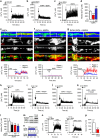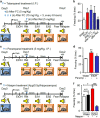Hippocampal encoding of interoceptive context during fear conditioning
- PMID: 28045462
- PMCID: PMC5545722
- DOI: 10.1038/tp.2016.254
Hippocampal encoding of interoceptive context during fear conditioning
Abstract
Rodent models of auditory fear conditioning are often used to understand the molecular mechanisms regulating fear- and anxiety-related behaviors. Conditioning and extinction memories are influenced by contextual cues, and the reinstatement of conditioned fear occurs when the conditioning stimulus is presented in a context different from the extinction context. Although it has been proposed that internal state is a feature of context that could influence extinction, contributions of interoception to conditioning have not been experimentally addressed. Here we use ethanol (EtOH) to show that interoceptive cues are encoded through the hippocampus by mechanisms that involve increased phosphorylation of GluR1 on serine 845, and biophysical alterations in neuronal membranes that facilitate stabilization of surface-located calcium-permeable n-2-amino-3-(5-methyl-3-oxo-1,2-oxazol-4-yl) propanoic acid (AMPA) receptor (AMPAR) into membrane microdomains. Conflicting interoceptive cues during extinction and fear relapse testing resulted in a failure to consolidate extinction that was reversed by the administration of AMPAR antagonists immediately following the retrieval cue.
Conflict of interest statement
The authors declare no conflict of interest.
Figures





Similar articles
-
Effects of ethanol on encoding, consolidation, and expression of extinction following contextual fear conditioning.Behav Neurosci. 2007 Dec;121(6):1280-92. doi: 10.1037/0735-7044.121.6.1280. Behav Neurosci. 2007. PMID: 18085881 Free PMC article.
-
Extinction of morphine-dependent conditioned behavior is associated with increased phosphorylation of the GluR1 subunit of AMPA receptors at hippocampal synapses.Eur J Neurosci. 2009 Jan;29(1):55-64. doi: 10.1111/j.1460-9568.2008.06560.x. Epub 2008 Dec 11. Eur J Neurosci. 2009. PMID: 19077125 Free PMC article.
-
Inhaled Lavandula angustifolia essential oil enhances extinction learning and inhibits memory updating in mice submitted to the contextual fear conditioning.J Ethnopharmacol. 2020 Oct 5;260:113048. doi: 10.1016/j.jep.2020.113048. Epub 2020 Jun 7. J Ethnopharmacol. 2020. PMID: 32525067
-
The Melatonergic System in Anxiety Disorders and the Role of Melatonin in Conditional Fear.Vitam Horm. 2017;103:281-294. doi: 10.1016/bs.vh.2016.09.003. Epub 2016 Oct 31. Vitam Horm. 2017. PMID: 28061973 Review.
-
Hippocampal involvement in contextual modulation of fear extinction.Hippocampus. 2007;17(9):749-58. doi: 10.1002/hipo.20331. Hippocampus. 2007. PMID: 17604353 Review.
Cited by
-
A precision medicine approach to pharmacological adjuncts to extinction: a call to broaden research.Psychopharmacology (Berl). 2019 Jan;236(1):143-161. doi: 10.1007/s00213-018-4999-0. Epub 2018 Aug 16. Psychopharmacology (Berl). 2019. PMID: 30116858 Review.
-
Interoception in Fear Learning and Posttraumatic Stress Disorder.Focus (Am Psychiatr Publ). 2023 Jul;21(3):266-277. doi: 10.1176/appi.focus.20230007. Epub 2023 Jun 28. Focus (Am Psychiatr Publ). 2023. PMID: 37404967 Free PMC article.
-
Inhibiting tau-induced elevated nSMase2 activity and ceramides is therapeutic in an Alzheimer's disease mouse model.Transl Neurodegener. 2023 Dec 4;12(1):56. doi: 10.1186/s40035-023-00383-9. Transl Neurodegener. 2023. PMID: 38049923 Free PMC article.
-
Differential Effects of Sevoflurane Exposure on Long-Term Fear Memory in Neonatal and Adult Rats.Mol Neurobiol. 2022 May;59(5):2799-2807. doi: 10.1007/s12035-021-02629-x. Epub 2022 Feb 24. Mol Neurobiol. 2022. PMID: 35201592
-
Chemogenetic stimulation of the infralimbic cortex reverses alcohol-induced fear memory overgeneralization.Sci Rep. 2019 Apr 30;9(1):6730. doi: 10.1038/s41598-019-43159-w. Sci Rep. 2019. PMID: 31040357 Free PMC article.
References
-
- Lee JL. Memory reconsolidation mediates the strengthening of memories by additional learning. Nat Neurosci 2008; 11: 1264–1266. - PubMed
-
- Lee S, Song B, Kim J, Park K, Hong I, An B et al. GluA1 phosphorylation at serine 831 in the lateral amygdala is required for fear renewal. Nat Neurosci 2013; 16: 1436–1444. - PubMed
MeSH terms
Substances
Grants and funding
LinkOut - more resources
Full Text Sources
Other Literature Sources

